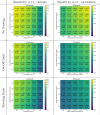Mitigating COVID-19 outbreaks in workplaces and schools by hybrid telecommuting
- PMID: 34437531
- PMCID: PMC8389398
- DOI: 10.1371/journal.pcbi.1009264
Mitigating COVID-19 outbreaks in workplaces and schools by hybrid telecommuting
Abstract
The COVID-19 epidemic has forced most countries to impose contact-limiting restrictions at workplaces, universities, schools, and more broadly in our societies. Yet, the effectiveness of these unprecedented interventions in containing the virus spread remain largely unquantified. Here, we develop a simulation study to analyze COVID-19 outbreaks on three real-life contact networks stemming from a workplace, a primary school and a high school in France. Our study provides a fine-grained analysis of the impact of contact-limiting strategies at workplaces, schools and high schools, including: (1) Rotating strategies, in which workers are evenly split into two shifts that alternate on a daily or weekly basis; and (2) On-Off strategies, where the whole group alternates periods of normal work interactions with complete telecommuting. We model epidemics spread in these different setups using a stochastic discrete-time agent-based transmission model that includes the coronavirus most salient features: super-spreaders, infectious asymptomatic individuals, and pre-symptomatic infectious periods. Our study yields clear results: the ranking of the strategies, based on their ability to mitigate epidemic propagation in the network from a first index case, is the same for all network topologies (workplace, primary school and high school). Namely, from best to worst: Rotating week-by-week, Rotating day-by-day, On-Off week-by-week, and On-Off day-by-day. Moreover, our results show that below a certain threshold for the original local reproduction number [Formula: see text] within the network (< 1.52 for primary schools, < 1.30 for the workplace, < 1.38 for the high school, and < 1.55 for the random graph), all four strategies efficiently control outbreak by decreasing effective local reproduction number to [Formula: see text] < 1. These results can provide guidance for public health decisions related to telecommuting.
Conflict of interest statement
I have read the journal’s policy and the authors of this manuscript have the following competing interests: L.O. has received research funding from Pfizer (through her research unit) on research related to meningococcal epidemiology and antimicrobial resistance. All other authors have declared that no competing interests exist.
Figures







References
-
- Malani A, Soman S, Asher S, Novosad P, Imbert C, Tandel V, et al. Adaptive control of COVID-19 outbreaks in India: Local, gradual, and trigger-based exit paths from lockdown. National Bureau of Economic Research; 2020.
-
- Ely J, Galeotti A, Steiner J. Rotation as Contagion Mitigation. CEPR Discussion Paper No DP14953. 2020.
-
- Casella F. Can the COVID-19 Epidemic Be Controlled on the Basis of Daily Test Reports? IEEE Control Systems Letters. 2021;5(3):1079–1084. doi: 10.1109/LCSYS.2020.3009912 - DOI
Publication types
MeSH terms
LinkOut - more resources
Full Text Sources
Medical

